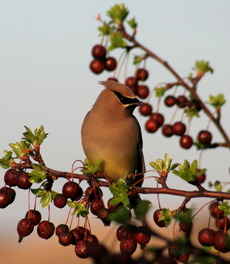 Identification
Identification
This beautiful golden brown bird with a pointed crest and black mask is named for its red-colored wing tips and yellow-tipped tail, as if it had been dipped in colored wax. Common to Minnesota, this social bird travels in groups in search of berries. You’ll likely hear them (if you can hear high pitches) before seeing them—their voice is a high, “thin lisp” or zeee. Look up when you hear that sound; you’ll likely see clusters of yellowish bellies looking suspiciously like goldfinches in size and color from below. Males and females look alike; juveniles appear grayer with streaks.
Habitat and Nesting
Cedar Waxwings may inhabit Minnesota year-round; they travel in large, nomadic flocks in search of food sources. Look for them in open woodlands, streamside areas and in fruiting trees and bushes (including cedars, the other part of their namesake).
Males and females build a cup-shaped nest, which hosts a single brood (occasionally two broods) per season. Eggs are pale blue with brown marks. Eggs incubate for 10–12 days; nestlings fledge in 14–18 days, with both male and female birds feeding young.
Diet
Cedar Waxwings dine primarily on berries, supplementing with insects as needed. If they’re in the area, they may stop in—en masse!—to take a sip from birdbaths, so make sure to keep them filled!

